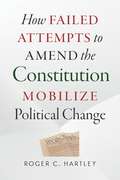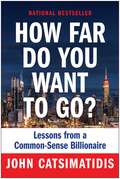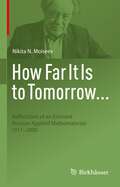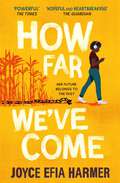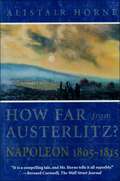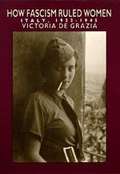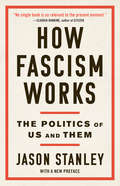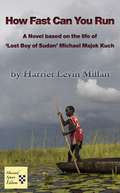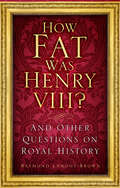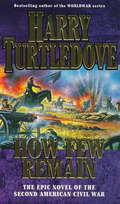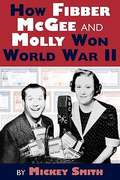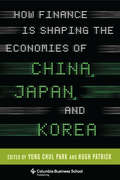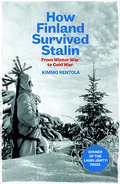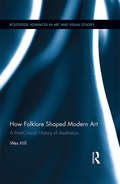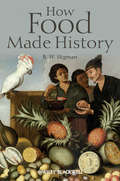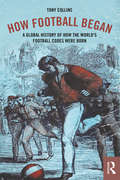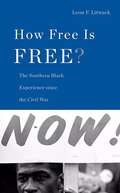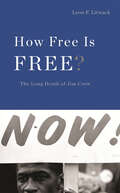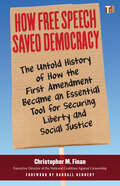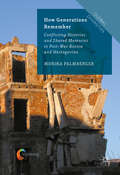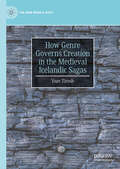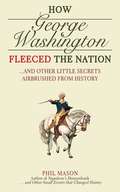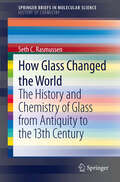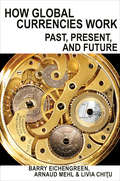- Table View
- List View
How Failed Attempts to Amend the Constitution Mobilize Political Change
by Roger C. HartleySince the Constitution's ratification, members of Congress, following Article V, have proposed approximately twelve thousand amendments, and states have filed several hundred petitions with Congress for the convening of a constitutional convention. Only twenty-seven amendments have been approved in 225 years. Why do members of Congress continue to introduce amendments at a pace of almost two hundred a year?This book is a demonstration of how social reformers and politicians have used the amendment process to achieve favorable political results even as their proposed amendments have failed to be adopted. For example, the ERA "failed" in the sense that it was never ratified, but the mobilization to ratify the ERA helped build the feminist movement (and also sparked a countermobilization). Similarly, the Supreme Court's ban on compulsory school prayer led to a barrage of proposed amendments to reverse the Court. They failed to achieve the requisite two-thirds support from Congress, but nevertheless had an impact on the political landscape. The definition of the relationship between Congress and the President in the conduct of foreign policy can also be traced directly to failed efforts to amend the Constitution during the Cold War.Roger Hartley examines familiar examples like the ERA, balanced budget amendment proposals, and pro-life attempts to overturn Roe v. Wade, but also takes the reader on a three-century tour of lesser-known amendments. He explains how often the mere threat of calling a constitutional convention (at which anything could happen) effected political change.
How Failed Attempts to Amend the Constitution Mobilize Political Change
by Roger C. HartleySince the Constitution's ratification, members of Congress, following Article V, have proposed approximately twelve thousand amendments, and states have filed several hundred petitions with Congress for the convening of a constitutional convention. Only twenty-seven amendments have been approved in 225 years. Why do members of Congress continue to introduce amendments at a pace of almost two hundred a year? This book is a demonstration of how social reformers and politicians have used the amendment process to achieve favorable political results even as their proposed amendments have failed to be adopted. For example, the ERA "failed" in the sense that it was never ratified, but the mobilization to ratify the ERA helped build the feminist movement (and also sparked a countermobilization). Similarly, the Supreme Court's ban on compulsory school prayer led to a barrage of proposed amendments to reverse the Court. They failed to achieve the requisite two-thirds support from Congress, but nevertheless had an impact on the political landscape. The definition of the relationship between Congress and the President in the conduct of foreign policy can also be traced directly to failed efforts to amend the Constitution during the Cold War. Roger Hartley examines familiar examples like the ERA, balanced budget amendment proposals, and pro-life attempts to overturn Roe v. Wade, but also takes the reader on a three-century tour of lesser-known amendments. He explains how often the mere threat of calling a constitutional convention (at which anything could happen) effected political change.
How Far Do You Want to Go?: Lessons from a Common-Sense Billionaire
by John CatsimatidisWall Street Journal Bestseller Publishers Weekly Bestseller Billionaire entrepreneur John Catsimatidis, owner and CEO of the Red Apple Group, reveals how his instincts and common sense have propelled him to massive business success in this detailed account of an incredible rags-to-riches story. Born on the small Greek island of Nisyros, John Catsimatidis immigrated to the States with his family and quickly became a true New Yorker, raised in Harlem. He went to school by day and worked in a small grocery store by night to help his parents pay the bills until, just eight credits short of graduating from New York University, he opted to work in the grocery business full-time. Today, that grocery business has become the Red Apple Group, a conglomerate with interests in energy, real estate, aviation, baseball, entertainment, and media, including the iconic radio station WABC, where John hosts leading figures in government, politics, business, and economics. As Catsimatidis has discovered, the American Dream doesn&’t come with an instruction manual—or even a sign to let you know when you&’ve arrived at the finish line. How Far Do You Want to Go? tells Catsimatidis&’s dynamic story, from his beginnings in the grocery business to entering the political arena, including a New York City mayoral campaign. He&’s tried his hand at nearly everything, but he&’s far from finished with his adventures. Now, he offers readers a glimpse into the wisdom he&’s gained—and the excitement he has for what the future holds in store.
How Far It Is to Tomorrow...: Reflections of an Eminent Russian Applied Mathematician 1917-2000
by Nikita N. MoiseevThis is a translated autobiography of applied mathematician N. N. Moiseev, providing an insider’s view of the history of the Soviet Union from its founding in 1917 to its collapse in 1991, as well as a little of the aftermath.We see vividly the precariousness of life just after the October Revolution; his happy family life during the years 1921-28 of Lenin’s New Economic Policy; the subsequent destruction of his family by Stalin’s regime; his trials as a social outcast; his student days at Moscow State University; his experiences as a Soviet Air Force Engineer in World War II, including sorties as a gunner and a brush with an NKVD agent; post-war euphoria, marriage, and another round of ostracism; and then the vicissitudes of a highly varied academic career. Here we meet many famous Soviet and Western engineers and scientists. The last several chapters are devoted more to wide-ranging reflections on God, philosophy, science, communism, modelling the biosphere, and the threat of nuclear winter. His thoughts concerning the impending and then final collapse of the USSR, as well as hopes for Russia’s future, conclude the journey through Moiseev's life.
How Far We've Come
by Joyce Efia HarmerFrom debut author, Joyce Efia Harmer, comes a groundbreaking YA story of friendship and freedom that crosses continents and centuries, in a timeslip novel exploring the legacy of slavery. 'A powerful debut' The TimesSometime, me love to dream that me is a human, a proper one, like them white folks is. Enslaved on a plantation in Barbados, Obah dreams of freedom. As talk of rebellion bubbles up around her in the Big House, she imagines escape. Meeting a strange boy who&’s not quite of this world, she decides to put her trust in him. But Jacob is from the twenty-first century. Desperate to give Obah a better life, he takes her back with him. At first it seems like dreams really do come true – until the cracks begin to show and Obah sees that freedom comes at an unimaginable cost . . . Both hopeful and devastating, this powerful novel about equality, how far we&’ve come, and how far we still have to go introduces an extraordinary new literary voice.
How Far from Austerlitz?: Napoleon 1805–1815
by Alistair HorneA London Sunday Times Book of the YearA Daily Telegraph Book of the YearAlistair Horne explores the theme of military success and failure in How Far From Austerlitz? chronicling Napoleon's rise and fall, drawing parallels with other great leaders of the modern era. The Battle of Austerlitz was Napoleon's greatest victory, the culmination of one of the greatest military campaigns of all time. It was also the last battle the "Father of Modern Warfare" would leave in absolute triumph, for, though he did not know it, Austerlitz marked the beginning of Napoleon's downfall. His triumph was too complete and his conquest too brutal to last. Like Hitler, he came to believe he was invincible, that no force could halt his bloody march across Europe. Like Hitler, he paid dearly for his hubris, climaxing in bitter defeat at Waterloo in 1815. In a matter of years, he had fallen from grace.
How Fascism Ruled Women: Italy, 1922-1945
by Victoria De Grazia"Italy has been made; now we need to make the Italians, " is a long-familiar Italian saying. Mussolini was the first head of government to include women in this mandate. What the fascist dictatorship expected of its female subjects and how they experienced the Duce's brutal but seductive rule are the main topics of Victoria de Grazia's new book. The author draws on an unusual array of sources--memoirs, novels, and reports on the images and events of mass culture, as well as government statistics and archival accounts--to present a broad yet detailed characterization of Italian women's ambiguous and ambivalent experience of a regime that promised women modernity, yet denied them freedom. Always attentive to the great diversity among women and careful to distinguish fascist rhetoric from the practices actually shaping daily existence, de Grazia moves with ease from the public discourse about maternity and family life to the images of femininity in commercial culture. The first study of women's experience under Italian fascism, this book offers a compelling treatment of the making of contemporary Italian society. With acute comparisons between the sexual politics of Italian fascism and developments elsewhere, including Hitler's Germany, de Grazia illuminates trends and dilemmas common to the construction of female citizenship in twentieth-century societies.
How Fascism Works: The Politics of Us and Them
by Jason StanleyNEW YORK TIMES BESTSELLER • &“No single book is as relevant to the present moment.&”—Claudia Rankine, author of Citizen&“With unsettling insight and disturbing clarity, How Fascism Works is an essential guidebook to our current national dilemma of democracy vs. authoritarianism.&”—Jelani Cobb, New Yorker staff writerA Yale philosopher identifies the ten pillars of fascist politics, and charts their horrifying rise and deep history.As a scholar of philosophy and propaganda and the child of refugees of WWII Europe, Jason Stanley has long understood that democratic societies, including the United States, can be vulnerable to fascism. In How Fascism Works, he identifies ten pillars of fascist politics—an appeal to the mythic past, propaganda, anti-intellectualism, unreality, hierarchy, victimhood, law and order, sexual anxiety, favoring &“the heartland,&” and a dismantling of public goods and unions—that amount to an urgent diagnosis of the tactics right-wing politicians use to break down democracies and a critical lens on the current moment. Stanley knits together reflections on history, philosophy, sociology, and critical race theory with stories from contemporary Hungary, Poland, India, Myanmar, and the United States, among other nations, making clear the immense dangers of language and beliefs that separate people into an &“us&” and a &“them.&” By uncovering disturbing patterns that are as prevalent today as ever, Stanley reveals that the stuff of politics—rhetoric and myth—can become policy and reality all too quickly. Only by recognizing them, he argues, can we begin to resist their most harmful effects and return to democratic ideals.
How Fast Can You Run: A Novel Based on the Life of 'Lost Boy of Sudan' Michael Majok Kuch
by Harriet Levin MillanA Novel based on the true story of Lost Boy of Sudan Michael Majok Kuch. Five-year-old Majok fled his village when the government in the North of Sudan ordered attacks against the South. Along with thousands of other refugees, Majok trekked through war zones and wilderness to a series of refugee camps where he would live for the next ten years. Michael Majok Kuch attended high school, college and graduate school in Philadelphia. He was a featured Lost Boy of Sudan in the PBS documentary, Dinka Diaries.
How Fat Was Henry VIII?: And 100 Other Questions on Royal History
by Raymond Lamont-BrownEver wondered how fat Henry VIII really was? Or what made Mary I ‘Bloody’?Over many hundreds of years, British royalty has had its fair share of accidents, rumours, scandals, misrepresentations and misconceptions. For instance, could Richard III be innocent of the deaths of the ‘Princes in the Tower’? And what really happened between Queen Victoria and her Highland servant John Brown?In today’s world, where newspapers clamour to report new revelations about the Royal Family, this informative and quirky book gives the inquisitive reader an in-depth look at the secrets of our past royals. For anyone curious about what went on behind the palace walls, Raymond Lamont-Brown answers those intriguing, confusing and mysterious questions we might have about our monarchs.
How Few Remain
by Harry TurtledoveA generation after the South won the first American civil War, America writhes once more in the bloody throes of battle. Furious over the annexation of key Mexican territory, the United States declares total war against the Confederate States. And so, in 1881, the fragile peace is shattered.But this is a new kind of war, fought on a lawless frontier where the Blue and the Grey battle not only each other but the Apache, the outlaw - and even the British Redcoat. For along with France, Britain enters the fray on the Confederate side. 'The wizard of If.' Chicago Sun-Times'The standard-bearer for alternate history.' USA Today
How Fibber Mcgee and Molly Won World War II
by Mickey C. SmithA detailed account with notes about the Fibber McGee and Molly show and its relationship to the Johnson wax company during World War II.
How Finance Is Shaping the Economies of China, Japan, and Korea (Columbia Business School Publishing)
by Hugh Patrick Meissner Larry Yung Chul ParkThis volume connects the evolving modern financial systems of China, Japan, and Korea to the development and growth of their economies through the first decade of the twenty-first century. It also identifies the commonalities among all three systems while accounting for their social, political, and institutional differences.Essays consider the reforms of the Chinese economy since 1978, the underwhelming performance of the Japanese economy since about 1990, and the growth of the Korean economy over the past three decades. These economies engaged in rapid catch-up growth processes and share similar economic structures. Yet while domestic forces have driven each country's financial trajectory, international short-term financial flows have presented opportunities and challenges for them all. The nature and role of the financial system in generating real economic growth, though nuanced and complex, is integral to these countries. The result is a fascinating spectrum of experiences with powerful takeaways.
How Finland Survived Stalin: From Winter War to Cold War, 1939-1950
by Kimmo RentolaA dramatic and timely account of Stalin&’s failed invasion of Finland in 1939, and the decade of wars and fraught relations that followed In November 1939, Stalin directed his military leaders to launch an invasion of Finland. In what became known as the Winter War, the full might of the Soviet army was pitted against this small Nordic republic. Yet despite their vastly superior military strength, the Soviets suffered heavy losses and failed to mount Stalin&’s intended full-scale invasion. How did Finland evade Stalin&’s crosshairs—not once, but three times more? In this groundbreaking account, Kimmo Rentola traces the epochal shifts in Soviet-Finnish relations. From the Winter War to Finland&’s exit from World War II in 1944, a possible Soviet-backed coup in 1948, and Moscow&’s designation of Finland as an enemy state in 1950, Finland was forced to navigate Stalin&’s outsize political and territorial demands. Rentola presents a dramatic reconstruction of Finland&’s unlikely survival at a time when the nation&’s very existence was at stake.
How Folklore Shaped Modern Art: A Post-Critical History of Aesthetics (Routledge Advances in Art and Visual Studies #15)
by Wes HillSince the 1990s, artists and art writers around the world have increasingly undermined the essentialism associated with notions of "critical practice." We can see this manifesting in the renewed relevance of what were previously considered "outsider" art practices, the emphasis on first-person accounts of identity over critical theory, and the proliferation of exhibitions that refuse to distinguish between art and the productions of culture more generally. How Folklore Shaped Modern Art: A Post-Critical History of Aesthetics underscores how the cultural traditions, belief systems and performed exchanges that were once integral to the folklore discipline are now central to contemporary art’s "post-critical turn." This shift is considered here as less a direct confrontation of critical procedures than a symptom of art’s inclusive ideals, overturning the historical separation of fine art from those "uncritical" forms located in material and commercial culture. In a global context, aesthetics is now just one of numerous traditions informing our encounters with visual culture today, symptomatic of the pull towards an impossibly pluralistic image of art that reflects the irreducible conditions of identity.
How Food Made History
by B. W. HigmanCovering 5,000 years of global history, How Food Made History traces the changing patterns of food production and consumption that have molded economic and social life and contributed fundamentally to the development of government and complex societies. Charts the changing technologies that have increased crop yields, enabled the industrial processing and preservation of food, and made transportation possible over great distances Considers social attitudes towards food, religious prohibitions, health and nutrition, and the politics of distribution Offers a fresh understanding of world history through the discussion of food
How Football Began: A Global History of How the World's Football Codes Were Born
by Tony CollinsThis ambitious and fascinating history considers why, in the space of sixty years between 1850 and 1910, football grew from a marginal and unorganised activity to become the dominant winter entertainment for millions of people around the world. The book explores how the world’s football codes - soccer, rugby league, rugby union, American, Australian, Canadian and Gaelic - developed as part of the commercialised leisure industry in the nineteenth century. Football, however and wherever it was played, was a product of the second industrial revolution, the rise of the mass media, and the spirit of the age of the masses. Important reading for students of sports studies, history, sociology, development and management, this book is also a valuable resource for scholars and academics involved in the study of football in all its forms, as well as an engrossing read for anyone interested in the early history of football.
How Free Is Free? The Long Death of Jim Crow
by Leon F. LitwackIn 1985, a black veteran of the civil rights movement offered a bleak vision of a long and troubled struggle. For more than a century, black southerners learned to live with betrayed expectations, diminishing prospects, and devastated aspirations. Their odyssey includes some of the most appalling examples of terrorism, violence, and dehumanization in the history of this nation. But, as Leon Litwack graphically demonstrates, it is at the same time an odyssey of resilience and resistance defined by day-to-day acts of protest: the fight for justice poignantly recorded in the stories, songs, images, and movements of a people trying to be heard. For black men and women, the question is: how free is free? Despite two major efforts to reconstruct race relations, injustices remain. From the height of Jim Crow to the early twenty-first century, struggles over racism persist despite court decisions and legislation. Few indignities were more pronounced than the World War II denial of basic rights and privileges to those responding to the call to make the world safe for democratic values that they themselves did not enjoy. And even the civil rights movement promise to redeem America was frustrated by change that was often more symbolic than real. Although a painful history to confront, Litwack's book inspires as it probes the enduring story of racial inequality and the ongoing fight for freedom in black America with power and grace.
How Free Is Free?: The Long Death of Jim Crow (The Nathan I. Huggins lectures)
by Leon F. LitwackIn 1985, a black veteran of the civil rights movement offered a bleak vision of a long and troubled struggle. For more than a century, black southerners learned to live with betrayed expectations, diminishing prospects, and devastated aspirations. Their odyssey includes some of the most appalling examples of terrorism, violence, and dehumanization in the history of this nation. But, as Leon Litwack graphically demonstrates, it is at the same time an odyssey of resilience and resistance defined by day-to-day acts of protest: the fight for justice poignantly recorded in the stories, songs, images, and movements of a people trying to be heard.For black men and women, the question is: how free is free? Despite two major efforts to reconstruct race relations, injustices remain. From the height of Jim Crow to the early twenty-first century, struggles over racism persist despite court decisions and legislation. Few indignities were more pronounced than the World War II denial of basic rights and privileges to those responding to the call to make the world safe for democratic values—values that they themselves did not enjoy. And even the civil rights movement promise to redeem America was frustrated by change that was often more symbolic than real.Although a painful history to confront, Litwack’s book inspires as it probes the enduring story of racial inequality and the ongoing fight for freedom in black America with power and grace.
How Free Speech Saved Democracy: The Untold History of How the First Amendment Became an Essential Tool for Secur ing Liberty and Social Justice (Sunlight Editions)
by Christopher M. Finan&“A historical demonstration of the indispensability of the First Amendment [and] … an earnest and timely argument for [its] enduring value.&” —Kirkus Reviews "Great storytelling about the history and importance of the First Amendment, from someone who has spent his life defending — and using — it." —Mary Beth TinkerFree speech is not an obstacle to change: it is the way change happensUncovering vivid and engaging stories about First Amendment pioneers, How Free Speech Saved Democracy shows how their struggle made possible the surging protests that aim to expand democracy today.How Free Speech Saved Democracy is a revealing reminder that First Amendment rights have often been curtailed in efforts to block progress, and that current measures to reduce hurtful language and to end hate speech could backfire on those who promote them.To those who see free speech as a threat to democracy, Finan offers engaging evidence from a long and sometimes challenging history of free speech in America to show how free speech has been essential to expanding democracy.From the beginning of American history, free speech has been used to advocate for change. In the 19th century, abolitionists, advocates for women&’s rights, and leaders of the labor movement had to fight for free speech. In the 20th century, the civil rights and anti-war movements expanded free speech, creating a shield for every protest movement we see today.Written by a historian who became a full-time defender of civil liberties and has spent four decades advocating for the rights of victims of censorship, this book grew out of Finan&’s desire to address the declining support for free speech that is occurring as our country becomes increasingly polarized.Through his evocative storytelling Finan demonstrates how the most effective antidote for the growth of hate speech and violence is support for and cultivation of the robust alternative of free speech.
How Generations Remember
by Monika PalmbergerThis book provides a profound insight into post-war Mostar, and the memories of three generations of this Bosnian-Herzegovinian city. Drawing on several years of ethnographic fieldwork, it offers a vivid account of how personal and collective memories are utterly intertwined, and how memories across the generations are reimagined and 'rewritten' following great socio-political change. Focusing on both Bosniak-dominated East Mostar and Croat-dominated West Mostar, it demonstrates that, even in this ethno-nationally divided city with its two divergent national historiographies, generation-specific experiences are crucial in how people ascribe meaning to past events. It argues that the dramatic and often brutal transformations that Bosnia and Herzegovina has witnessed have led to alterations in memory politics, not to mention disparities in the life situations faced by the different generations in present-day post-war Mostar. This in turn has created variations in memories along generational lines, which affect how individuals narrate and position themselves in relation to the country's history. This detailed and engaging work will appeal to students and scholars of anthropology, sociology, political science, history and oral history, particularly those with an interest in memory, post-socialist Europe and conflict studies.
How Genre Governs Creation in the Medieval Icelandic Sagas (The New Middle Ages)
by Yoav TiroshThis book sets out to answer why genre matters when analysing sagas, medieval literature, and creation in general. How Genre Governs Creation in the Medieval Icelandic Sagas applies theoretical observations on the workings of genre to saga literature analysis, including media and film genre theory, as well as observations from reader-response theory. The text primarily focuses on Íslendingasögur, a group of prose or prosimetric texts that concern the medieval Norse world, usually taking place in the period between the end of the ninth and the mid-eleventh centuries and focusing on Iceland. Tirosh proposes new interpretations to several sagas, but more importantly provides a fresh perspective on the importance and application of genre theory to medieval literary studies.
How George Washington Fleeced the Nation: And Other Little Secrets Airbrushed From History
by Phil MasonOur view of the famous is one-dimensional--leading figures from history are summarized in history textbooks with one or two lines: Churchill the war-time genius, Gandhi the poor ascetic--but nobody is perfect and even the famous have their quirks and hidden secrets. How George Washington Fleeced the Nation reveals the often hilarious, sometimes shocking, and always highly informative foibles of the great and the good. Einstein, the most brilliant man who lived, regularly forgot his shoes and never learned to drive. Hitler possibly has a Jewish ancestor. Picasso avoided paying restaurant bills by doodling on their napkins instead. Prepared to be shocked, amused, and outraged at what they didn't teach you in high school.
How Glass Changed the World
by Seth C. RasmussenGlass production is thought to date to ~2500 BC and had found numerous uses by the height of the Roman Empire. Yet the modern view of glass-based chemical apparatus (beakers, flasks, stills, etc.) was quite limited due to a lack of glass durability under rapid temperature changes and chemical attack. This "brief" gives an overview of the history and chemistry of glass technology from its origins in antiquity to its dramatic expansion in the 13th century, concluding with its impact on society in general, particularly its effect on chemical practices.
How Global Currencies Work: Past, Present, and Future
by Barry Eichengreen Arnaud Mehl Livia ChituA powerful new understanding of global currency trends, including the rise of the Chinese yuanAt first glance, the modern history of the global economic system seems to support the long-held view that the leading world power’s currency—the British pound, the U.S. dollar, and perhaps someday the Chinese yuan—invariably dominates international trade and finance. In How Global Currencies Work, three noted economists provide a reassessment of this history and the theories behind the conventional wisdom.Offering a new history of global finance over the past two centuries, and marshaling extensive new data to test established theories of how global currencies work, Barry Eichengreen, Arnaud Mehl, and Livia Chiţu argue for a new view, in which several national monies can share international currency status, and their importance can change rapidly. They demonstrate how changes in technology and in the structure of international trade and finance have reshaped the landscape of international currencies so that several international financial standards can coexist. They show that multiple international and reserve currencies have in fact coexisted in the pastupending the traditional view of the British pound’s dominance prior to 1945 and the U.S. dollar’s dominance more recently.Looking forward, the book tackles the implications of this new framework for major questions facing the future of the international monetary system, from whether the euro and the Chinese yuan might address their respective challenges and perhaps rival the dollar, to how increased currency competition might affect global financial stability.
